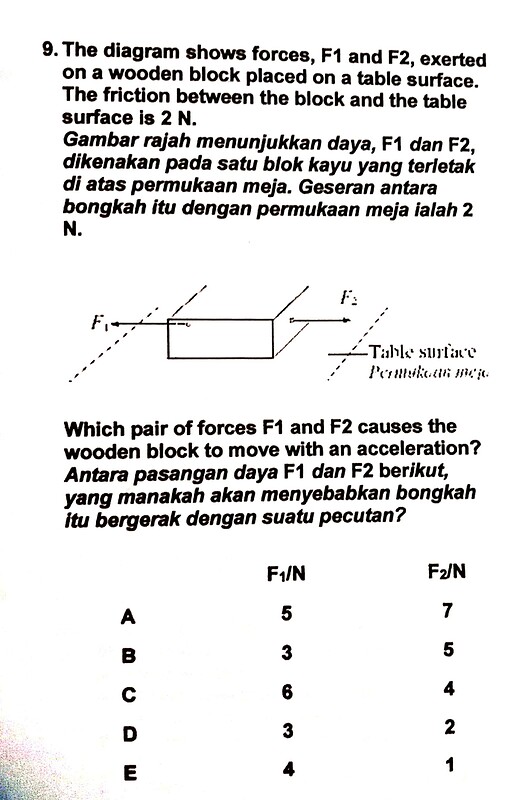Hi Farhaini,
SPM Physics 2005 Q9 P1
- The diagram shows forces, F 1 and F 2, exerted on a wooden block placed on a table surface. The friction between the block and the table surface is 2 \mathrm{~N}. Gambar rajah menunjukkan daya, F1 dan F2, dikenakan pada satu blok kayu yang terletak di atas permukaan meja. Geseran antara bongkah itu dengan permukaan meja ialah 2
N.
Which pair of forces \mathrm{F} 1 and \mathrm{F} 2 causes the wooden block to move with an acceleration? Antara pasangan daya F1 dan F2 berikut, yang manakah akan menyebabkan bongkah itu bergerak dengan suatu pecutan?
\begin{array}{ccc} & \mathbf{F}_{1} \mathbf{N} & \mathbf{F}_{2} / \mathbf{N} \\ \text { A } & \mathbf{5} & \mathbf{7} \\ \mathbf{B} & \mathbf{3} & \mathbf{5} \\ \mathbf{C} & \mathbf{6} & \mathbf{4} \\ \mathbf{D} & \mathbf{3} & \mathbf{2} \\ \mathbf{E} & \mathbf{4} & \mathbf{1}\end{array}
SPM Physics 2005 Q9 P1 Solution
For the block to move, resultant force has to be greater than frictional force of 2N.
Since forces F1 and F2 are in the opposite directions,
|Magnitude of Resultant Force| = |F1 - F2|
Note: “| |” means value inside will become positive even if it is negative.
Hence, |F1 - F2| need to be greater than the frictional force of 2N.
For E,
|Magnitude of resultant force| = |F1 - F2| = |4 - 1| = 3N
Since resultant force > 2N, E is the answer. For all other options, resultant force is NOT greater than 2N.
I understand now. Thank you so much !



You are very welcome 



